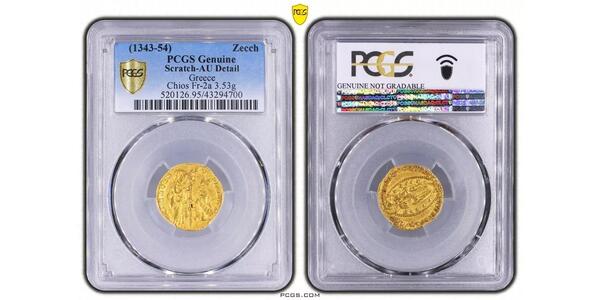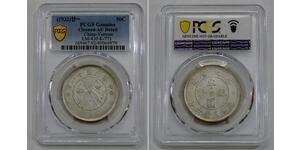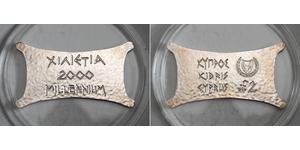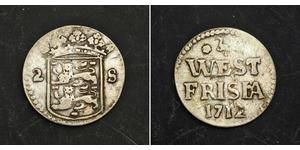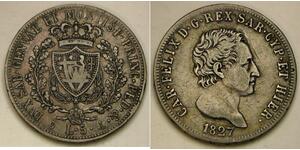1347-1385, Crusaders, Chios, Maona Society. Gold Ducat Coin. (3.53gm) PCGS AU+
Mint Place: Chios (Genoese occupation)
Condition: Certified and graded by PCGS as AU (Details: Scratch!)
Denomination: Gold Ducat (Zecchino) - issued in the name of the Venetian Doge Andrea Dandulo.
Mint Period: 1347-1385 AD (the slabs says 1343-1354, which refers to the ruling period of the Doge Andrea Dandulo)
Reference: Friedberg 2a (Chios), Lunardi CS6, Gamberini 344 (Roberto d'Angio pr. Acaia), Gamberini 395 (Chios/La Maona). R!
Diameter: 20mm
Weight: 3.53gm
Material: Gold!
Obverse: St. Mark standing right, presenting cross topped bannerto kneeling Doge.
Legend: S/N/V/Є/N/Є/T/I D/V/X ΛNDR DΛNDVLO
Reverse: Christ standing facing, raising hand in benediction and holding Gospels.
Legend: · SIT · T XPЄ · DΛT Q TV · RЄGIS · ISTЄ · DVCΛT ·
Comment: Halo of light (mandorla) with 9 stars around.
Maona of Chios and Phocaea (Italian: Maona di Chio e di Focea; 1346–1566) was a maona formed to exact taxes for the Republic of Genoa from the island of Chios and port of Phocaea. Genoa sold the rights to their taxes to the maona, which raised funds from its investors to buy galleys and eventually re-conquer Chios and Phocaea.
The Genoese authorities of Chios and their Greek subjects (who constituted the majority of island's population - 80%) were subjects of the Republic of Genoa. Initially, many of the Mahona associates and therefore members of the island's administration were citizens as well as inhabitants of Genoa. The members of the company for more than two centuries were entitled to the revenues deriving from the natural or economic resources of the island. In return they had to pay an annual tribute to Genoa.
After two years, the original shareholders that lived in Genoa sold their shares to some colonists that already lived in Chios or to some Genoese citizens that migrated to the island. These new members constituted the New Mahona that was also subsequently became known as the Mahona (or Maona) of the Giustiniani. Since the Republic was unable to redeem the island from the Giustiniani, Chios remained in their possession till its final fall to the Turks. In the mean-time the Mahonesi had to pay tributes to Genoa, at the beginning to the Byzantine emperor John V Palaiologos in 1363 and finally to the Turks.
The republic engaged to secure these citizens against all loss, and pledged a portion of the annual revenues of the state pay the interest on their advances. Each subscriber had paid down 400 Genoese livres; twenty-six galleys had been equipped by the commons and three by the nobles. Once the conquest of Chios was successfully achieved, the ship-owners then returned to Genoa and advanced the sum of 250,000 lire to cover the expenses of the campaign. After long deliberations, an agreement was concluded on 26 February 1347 between the Commune and the group of its creditors represented by the Genoese admiral Simone Vignoso. This association took the name of Maona of Chios. The debt owed to the ship-owners was repaid in shares, or "luoghi", to an amount of 203,000 Genoese lire.
This was less than the commanders of the ships demanded, but nonetheless they got property and the administration of Chios and Phocaea, in addition to the revenues provided by the "luoghi". The more-or-less forced benevolence of the ship-owners made up for the deficiencies of the state, which was then obliged to hand over public revenues to them to meet its obligations.
The Genoaee family of Giustiniani, with their Maona, governed Chios, appointing a commissioner and commanding 52 military Genuates (tribes from around Genoa) in the island: during these years (1346-1566), the trade revived and the island enjoyed huge prosperity.
The Mahona of Chios ended its activities in 1566 when the Turks invaded and occupied the island. Admiral Piyale Pasha annexed it to the Ottoman Empire. His sultan had a good pretext for putting an end to the government of the Giustiniani, for the island served as a place of refuge for fugitive slaves and the refreshment of Christian corsairs.
Chios is the fifth largest of the Greek islands, situated in the Aegean Sea, seven kilometres (five miles) off the Asia Minor coast. The island is separated from Turkey by the Chios Strait. The island is noted for its strong merchant shipping community, its unique mastic gum and its medieval villages.
After the permanent division of the Roman Empire in 395 AD, Chios was for six centuries part of the Byzantine Empire. This came to an end when the island was briefly held (1090–97) by Çaka Bey, a Turkish emir in the region of Smyrna during the first expansion of the Turks to the Aegean coast. However, the Turks were driven back from the Aegean coast by the First Crusade, and the island reverted to Byzantine rule.
This relative stability was ended by the sacking of Constantinople during the Fourth Crusade (1204) and during the turmoil of the 13th century the island ownership was constantly affected by the regional power struggles.
After the Fourth Crusade, the Byzantine empire was divided up by the Latin emperors of Constantinople, with Chios nominally becoming a possession of the Republic of Venice. However, defeats for the Latin empire resulted in the island reverting to Byzantine rule in 1225.
Through the Treaty of Nymphaeum the authority of Chios was ceded to the Republic of Genoa (1261). At this time the island was frequently attacked by pirates and by 1302–1303 was a target for the renewed Turkish fleets. To prevent Turkish expansion, the island was reconquered and kept as a renewable concession, at the behest of the Byzantine emperor Andronicus II, by the Genovese Benedetto I Zaccaria (1304), then admiral to Philip of France. Zaccaria installed himself as ruler of the island, in the short-lived Lordship of Chios. His rule was benign and effective rule remained in the hands of the local Greek landowners. Beneto Zacharia was followed by his nephew (Benedetto II) and then son (Martino). They attempted to turn the island towards the Latin and Papal powers, and away from the predominant Byzantine influence. The locals, still loyal to the Byzantine Empire, responded to a letter from the emperor and, despite a standing army of a thousand infantrymen, a hundred cavalrymen and two galleys, expelled the Zacharia family from the island (1329) and dissolved the fiefdom.
Local rule was brief. In 1346, a Chartered company or Maona (the "Maona di Chio e di Focea") was set up in Genoa to reconquer and exploit Chios and the neighbouring town of Phocaea in Asia Minor. Although the islanders firmly rejected an initial offer of protection, the island was invaded by a Genoese Fleet, led by Simone Vignoso, and the castle besieged. Again rule was transferred peacefully, as on 12 September the castle was surrendered and a treaty signed with no loss of privileges to the local landowners as long as the new authority was accepted.
The Genoese, being interested in profit rather than conquest, controlled the trade-posts and warehouses, in particular the trade of mastic, alum, salt and pitch. Other trades such as grain, wine oil and cloth and most professions were run jointly with the locals. After a failed uprising in 1347, and being heavily outnumbered (less than 10% of the population in 1395), the Latins maintained light control over the local population, remaining largely in the town and allowing full religious freedom. In this way the island remained under Genoese control for two centuries.
By the early 15th century, Asia Minor and the surrounding islands had fallen under Ottoman rule, however the Genoese families managed to maintain control over the island through the payment of a tribute to the Sultan. By the 16th century, as Genoese power waned, trade with Genoa had decreased and the local rulers become assimilated into the local population.
This largely independent rule of Genoese families continued until 1566, when, with tensions rising, the Sultan decided that the island could potentially be used as a base for Western attacks on Constantinople. The island was invaded by Ottoman troops and absorbed into the Ottoman Empire. Consequently, Greek Phanariotes gradually replaced these Genoese families as a protectorate of Chios and maintained relative autonomy despite the Ottoman occupation.
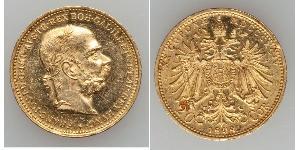
20 Corona Österreich-Ungarn (1867-1918) ...
Diese Gruppe hat 6 Münzen / 3 Preise
Add coin to this group
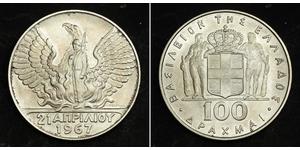
100 Drachma Königreich Griechenland (194 ...
Diese Gruppe hat 6 Münzen / 6 Preise
Add coin to this group

5 Pound Gibraltar Silber Elizabeth II (1 ...
Diese Gruppe hat 10 Münzen / 10 Preise
Add coin to this group
2 Stuiver Niederlande Silber
Diese Gruppe hat 2 Münzen / 2 Preise
⇑
5 Lira Italian city-states Silber Karl Felix (Sardinien-Piemont)
Diese Gruppe hat 18 Münzen / 16 Preise
⇑

